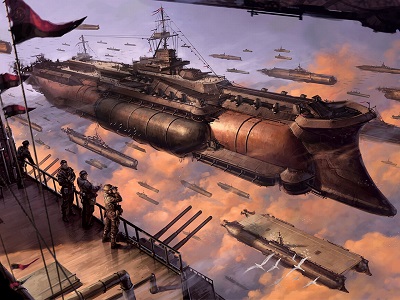We don't use intrusive ads and hope you disable your adblock.

Steampunk
Description
Steampunk is a sub-genre of science fiction that typically features steam-powered machinery, especially in a setting inspired by industrialized Western civilization during the 19th century. Steampunk works are often set in an alternative history of the 19th century`s British Victorian era or American "Wild West", in a post-apocalyptic future during which steam power has regained mainstream use, or in a fantasy world that similarly employs steam power.
Noteworthy attributes of the theme include large amounts smoke pollution from wood or coal burning, the affinity to metal constructs like cogs and metal tubing, and the mechanization of everyday objects.
Steampunk perhaps most recognisably features anachronistic technologies or retro-futuristic inventions as people in the 19th century might have envisioned them, and is likewise rooted in the era`s perspective on fashion, culture, architectural style, and art.
Such technology may include fictional machines like those found in the works of H. G. Wells and Jules Verne, or the modern authors Philip Pullman, Scott Westerfeld, Stephen Hunt and China Miéville. Other examples of steampunk contain alternative history-style presentations of such technology as lighter-than-air airships, analog computers, or such digital mechanical computers as Charles Babbage`s Analytical Engine.
Steampunk can also exemplify everything that is bad about unrestrained technological progress (dead matter), when compared to life and nature. The anime usually makes a point to propound the latter.
Noteworthy attributes of the theme include large amounts smoke pollution from wood or coal burning, the affinity to metal constructs like cogs and metal tubing, and the mechanization of everyday objects.
Steampunk perhaps most recognisably features anachronistic technologies or retro-futuristic inventions as people in the 19th century might have envisioned them, and is likewise rooted in the era`s perspective on fashion, culture, architectural style, and art.
Such technology may include fictional machines like those found in the works of H. G. Wells and Jules Verne, or the modern authors Philip Pullman, Scott Westerfeld, Stephen Hunt and China Miéville. Other examples of steampunk contain alternative history-style presentations of such technology as lighter-than-air airships, analog computers, or such digital mechanical computers as Charles Babbage`s Analytical Engine.
Steampunk can also exemplify everything that is bad about unrestrained technological progress (dead matter), when compared to life and nature. The anime usually makes a point to propound the latter.
Related Anime

TV Series
2009
64 Eps
Completed


OVA
2013
8 Eps
Completed